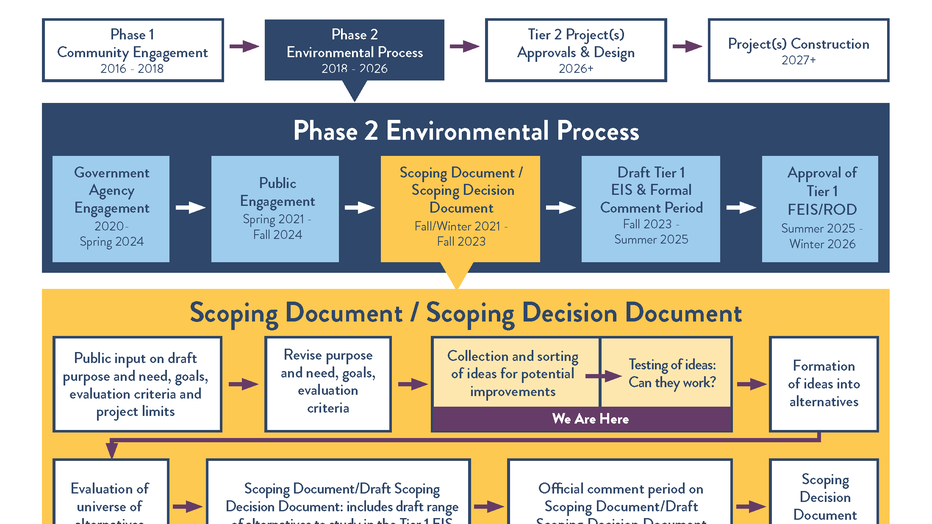'Rethinking I-94’ looks to reconnect St. Paul neighborhoods, residents

MnDOT unveils options for I-94 project
The Minnesota Department of Transportation (MnDOT) continues to study ways in which the creation of I-94 impacted neighborhoods in St. Paul, and review ways in which it could be potentially reconnect them more than 50 years later.
ST. PAUL, Minn. (FOX 9) - The Minnesota Department of Transportation (MnDOT) continues to study ways in which the creation of Interstate 94 impacted neighborhoods in St. Paul, and review ways in which it could potentially reconnect them more than 50 years later.
Construction of I-94 during the 1960s essentially split the Rondo neighborhood of St. Paul, replacing homes with concrete and making the neighborhood inaccessible to many.
In 2016, MnDOT formed "Rethinking I-94" in part to study the effects the I-94 corridor had on the Rondo neighborhood and more, as well as review potential solutions to mitigate them. In part, the "Rethinking I-94" project is a long-term effort to improve MnDOT’s engagement and relationships with communities along a 15-mile stretch of I-94 between Broadway Avenue in Minneapolis and Highway 61 in St. Paul.

MnDOT unveiling I-94 corridor project options
MnDOT on Monday will unveil its Interstate 94 corridor project options. A group has been advocating to put a land bridge over I-94 to reconnect the Rondo neighborhood in St. Paul.
While MnDOT's responsibilities on I-94 include, "preserving and repairing bridges, walls and pavement and enhancing mobility, safety, and connectivity," the project is attempting to, "engage with those who live, work, and play along the corridor" to "build and sustain healthy, equitable communities." Neighborhoods along I-94 are home to nearly 750,000 people, several colleges and universities, libraries, art galleries, theaters, parks and museums.
According to their website, "Rethinking I-94" improvements are meant to support the health and equity of the surrounding communities. The goal is to avoid repeating the mistakes made in the 1960s when the construction of I-94 destroyed numerous homes and neighborhoods.
With a projected cost of nearly $500 million, construction on the corridor project wouldn't start until 2027 or later. The project is currently in phase two of four, and seeking community input on design.
According to MnDOT, the process is following the guidelines of the National Environmental Policy Act (NEPA), which federally mandates to draft the goals, purposes, needs, and criteria to evaluate projects. The department is also working with the Federal Highway Administration and an advisory committee of policymakers throughout the process for projected funding.
There are 10 options, or what MnDOT calls "alternatives," for the corridor, which is a 15-mile stretch between Minneapolis and St. Paul. Three transit stops are getting more reviews: 25th/27th Avenue, Snelling Avenue and Dale Street.

With a projected cost of nearly $500 million, construction on the corridor project wouldn't start until 2027 or later. The project is currently in phase two of four, and seeking community input on design.
"We really heard that people wanted to see an at-grade alternative. We stuck with our ‘no-build’ alternative. We have some that expand the freeway. We have some that make the freeway smaller. We have some increased transit options for the freeway," said Melissa Barnes, the project manager for "Rethinking I-94."
Nancy Daubenberger, the commissioner of transportation for MnDOT, said there is no "preferred" alternative.
"We're focusing on the most basic elements first: roadway type, the number and type of lanes, transit service, and potential transit stop locations," Daubenberger said.
Daubenberger added the process progresses, state officials will have a better understanding of how to improve the ability to walk and bike along the corridor, and whether details such as trees, landscaping and noise walls will be added along the route.
MnDOT recognizes that building the freeway in the 60s destroyed homes and devastated communities like St. Paul's Rondo neighborhood. Separately from the MnDOT project, a non-profit called ReConnect Rondo is leading the effort to get a land bridge built over the freeway.
To address the harm done to the community decades ago, groups like Our Streets Minneapolis have been advocating for the stretch of I-94 to be converted into a boulevard.
"In order to achieve racial and class equity, we must decolonize the project quarter by removing I-94, return the land to the community, and prioritize benefits for those who were harmed most," said José Antonio Zayas Cabán, the executive director for Our Streets Minneapolis.
During the public comments section of Monday’s meeting, multiple community members asked MnDOT to consider the climate and public health effects of the proposals, not just the transportation components.
Members of the advisory committee, which includes several elected officials from St. Paul, Minneapolis, and their corresponding counties, said they need some time to consider the options.
"We strongly oppose repairing or reconstructing the freeway as is. We strongly oppose any expansion of the freeway," said Mitra Jalali, Ward 4 from St. Paul City Council.

